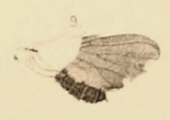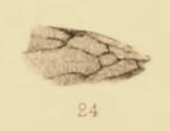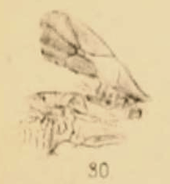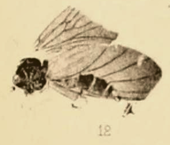1877_in_paleontology
1877 in paleontology
Overview of the events of 1877 in paleontology
Paleontology or palaeontology is the study of prehistoric life forms on Earth through the examination of plant and animal fossils.[1] This includes the study of body fossils, tracks (ichnites), burrows, cast-off parts, fossilised feces (coprolites), palynomorphs and chemical residues. Because humans have encountered fossils for millennia, paleontology has a long history both before and after becoming formalized as a science. This article records significant discoveries and events related to paleontology that occurred or were published in the year 1877.
| |||
|---|---|---|---|
|
Newly named crustaceans
| Name | Novelty | Status | Authors | Age | Unit | Location | Notes | Images |
|---|---|---|---|---|---|---|---|---|
|
Anthrapalaemon woodwardi[2] |
Sp nov |
jr synonym |
Moved to the genus Tealliocaris in 1908[3] |
|||||
Newly named insects
| Name | Novelty | Status | Authors | Age | Type locality | Country | Notes | Images |
|---|---|---|---|---|---|---|---|---|
|
Anthomyia burgessi[4] |
Sp nov |
Quesnel |
An anthomyiid fly. |
 (1890 illustration) | ||||
|
Anthomyia inanimata[4] |
Sp nov |
Quesnel |
An anthomyiid fly. |
 (1890 illustration) | ||||
|
Sp nov |
Quesnel |
A myrmicine ant, possibly nomen dubium.[7] |
 (1890 illustration) | |||||
|
Boletina sepulta[4] |
Sp nov |
valid |
Quesnel |
A fungus gnat. |
 (1890 illustration) | |||
|
Brachypeza abita[4] |
Sp nov |
valid |
Quesnel |
 (1890 illustration) | ||||
|
Brachypeza procera[4] |
Sp nov |
valid |
Quesnel |
 (1890 illustration) | ||||
|
Calyptites[4] |
Gen et sp nov |
valid |
Quesnel |
An ant of uncertain placement. |
 (1890 illustration) | |||
|
Formica arcana[4] |
Sp nov |
valid |
Quesnel |
A formicine ant |
 (1890 illustration) | |||
|
Hypoclinea obliterata[4] |
Sp nov |
jr synonym |
Quesnel |
A dolichoderine ant |
 (1890 illustration) | |||
|
Heteromyza senilis[4] |
Sp nov |
valid |
Quesnel |
 (1890 illustration) | ||||
|
Lachnus petrorum[4] |
Sp nov |
jr synonym |
Quesnel |
An aphidomorph of uncertain placement |
 (1890 illustration) | |||
|
Liometopum pingue[6] |
Sp nov |
valid |
An ant species, moved to Eoformica pingue in 1930 |
 | ||||
|
Lithortalis[4] |
Gen et sp nov |
valid |
Quesnel |
A picture-winged fly. |
 (1890 illustration) | |||
|
Lonchaea senescens[4] |
Sp nov |
valid |
Quesnel |
A lauxaniid fly. |
 (1890 illustration) | |||
|
Palloptera morticina[4] |
Sp nov |
valid |
Quesnel |
 (1890 illustration) | ||||
|
Pimpla decessa[4] |
Sp nov |
valid |
Quesnel |
A pimpline ichneumon parasitic wasp |
 (1890 illustration) | |||
|
Pimpla saxea[4] |
Sp nov |
valid |
Quesnel |
A pimpline ichneumon parasitic wasp |
 (1890 illustration) | |||
|
Pimpla senecta[4] |
Sp nov |
valid |
Quesnel |
A pimpline ichneumon parasitic wasp |
 (1890 illustration) | |||
|
Prometopia depilis[4] |
Sp nov |
valid |
Quesnel |
 (1890 illustration) | ||||
|
Sciomyza revelata[4] |
Sp nov |
valid |
Quesnel |
A marsh fly. |
 (1890 illustration) | |||
|
Trichonta dawsoni[4] |
Sp nov |
valid |
Quesnel |
 (1890 illustration) | ||||
| Name | Novelty | Status | Authors | Age | Unit | Location | Notes | Images |
|---|---|---|---|---|---|---|---|---|
|
gen et sp nov. |
Valid |
One of two stingrays from the Green River Formation |
| |||||
| Name | Novelty | Status | Authors | Age | Unit | Location | Notes | Images |
|---|---|---|---|---|---|---|---|---|
|
Junior synonym |
Late Triassic |
A misidentified ornithosuchid archosaur whose name was preoccupied by MacLeay, 1819. It was later renamed Dasygnathoides. Synonym of Ornithosuchus | ||||||
|
Late Triassic |
Dubious genus of misidentified phytosaur. | |||||||
|
Dubious genus of misidentified phytosaur. | ||||||||
Laelaps trihedrodon, Cope criticizes Dryptosaurus
O. W. Lucas collected the first remains of what would later in the year be named Laelaps trihedrodon from Quarry I of the Saurian Hill at Garden Park, Colorado.[12] Edward Drinker Cope would describe the material later in the year in a short paper titled "On a carnivorous dinosaurian from the Dakota beds of Colorado."[13] The "Dakota beds" he references are actually Morrison Formation strata.[12] Cope claims to have a skeleton of unspecified completeness on which to establish the new species, but only describes a partial dentary which has 5 successional teeth, 2 functional teeth, and one tooth missing from its socket.[13] All of the preceding material has since been lost to science with the exception of 5 broken, partial tooth crowns.[14] From the now missing dentary, Cope infers that the creature is a carnivore and compares its dentition to that belonging to other members of his infamous genus "Laelaps", L. aquilunguis and L. incrassatus.[13] Cope concludes the paper with a pointed criticism of his rival O. C. Marsh's attempt to rename Laelaps as the genus Dryptosaurus because the generic name Laelaps has been used in entomology.[15] Cope claims that since the mite genus Laelaps was a synonym that the name was not truly preoccupied and Marsh's erection of Dryptosaurus has therefore created a new, redundant synonym of Laelaps the dinosaur.[15] However, subsequent researchers have supported Marsh's new name.
Apatosaurus
- Apatosaurus specimen found with preserved gastroliths.[16]
New genera
|
||||||||||||||||||||||||||||||||||||||||||||||||||||||||||||||||||||||||||||||||||||||||||||||||||||||||||||||||||||||||||
Non-mammalian
| Name | Status | Authors | Age | Location | Notes | Images |
|---|---|---|---|---|---|---|
|
Synonym of Clepsydrops |
||||||
- Gini-Newman, Garfield; Graham, Elizabeth (2001). Echoes from the past: world history to the 16th century. Toronto: McGraw-Hill Ryerson Ltd. ISBN 9780070887398. OCLC 46769716.
- Etheridge, R. (1877). "On the Occurrence of a Macrurous Decapod (Anthrapalæmon? Woodwardi, sp. nov.) in the Red Sandstone, or lowest group, of the Carboniferous Formation in the South-east of Scotland". Quarterly Journal of the Geological Society. 33 (1–4): 863–878. doi:10.1144/GSL.JGS.1877.033.01-04.49. ISSN 0370-291X. S2CID 140182850.
- Peach, B. N. (1908). Monograph on the higher Crustacea of the Carboniferous rocks of Scotland. Glasgow: Printed for H.M. Stationery off., by J. Hedderwick & sons, ltd.
- Scudder, S. H (1877). "Appendix to Mr. George M. Dawson's report. The insects of the Tertiary beds at Quesnel". Geological Survey of Canada, Report of Progress for. 1875–1876: 266–280.
- Michelsen, V. (1996). "First reliable record of a fossil species of Anthomyiidae (Diptera), with comments on the definition of recent and fossil clades in phylogenetic classification". Biological Journal of the Linnean Society. 58 (4): 441–451.
- Carpenter, F. M. (1930). "The fossil ants of North America" (PDF). Bulletin of the Museum of Comparative Zoology. 70: 1–66.
- Radchenko, A. G.; Perkovsky, E. E. (2016). "The ant Aphaenogaster dlusskyana sp. nov. (Hymenoptera, Formicidae) from the Sakhalin amber—the earliest described species of an extant genus of Myrmicinae". Paleontological Journal. 50 (9): 936–946. doi:10.1134/S0031030116090136.
- Dalla Torre, K. W. (1893). Catalogus Hymenopterorum hucusque descriptorum systematicus et synonymicus. Vol. 7. Formicidae (Heterogyna). Leipzig: W. Engelmann. p. 289.
- Scudder, S. H. (1890). "The Tertiary insects of North America". United States Geological Survey of the Territories, Washington: 615.
- Evenhuis (1994). Catalogue of the Fossil Flies of the World (Insecta: Diptera). Backhuys Publishers. pp. 1–600.
- Grande, Lance (1984), "Paleontology of the Green River Formation, with a review of the fish fauna", Bulletin of the Wyoming State Geological Survey, 63 2nd ed., Laramie, WY
- "Introduction," Chure (2001) page 11.
- Cope (1887) pages 805-806.
- "Description of 5780," Chure (2001) page 11.
- Cope (1887) page 806.
- Cannon (1907). Sanders, Manley, and Carpenter (2001), "Table 12.1" page 167.
- Cannon, G.L. (1907). Sauropodan gastroliths. Science 24, 116.
- Chure, Daniel J. (2001). "On the type and referred material of Laelaps trihedrodon Cope 1877 (Dinosauria: Theropoda)". In Tanke, Darren; Carpenter, Kenneth (eds.). Mesozoic Vertebrate Life. Bloomington and Indianapolis: Indiana University Press. pp. 10–18. ISBN 0-253-33907-3.
- Cope, E.D. (1877). On a carnivorous dinosaurian from the Dakota beds of Colorado. Bull. U.S. Geol. Surv. Territories 3: 805–806.
- Sanders F, Manley K, Carpenter K. Gastroliths from the Lower Cretaceous sauropod Cedarosaurus weiskopfae. In: Tanke D.H, Carpenter K, editors. Mesozoic vertebrate life: new research inspired by the paleontology of Philip J. Currie. Indiana University Press; Bloomington, IN: 2001. pp. 166–180.